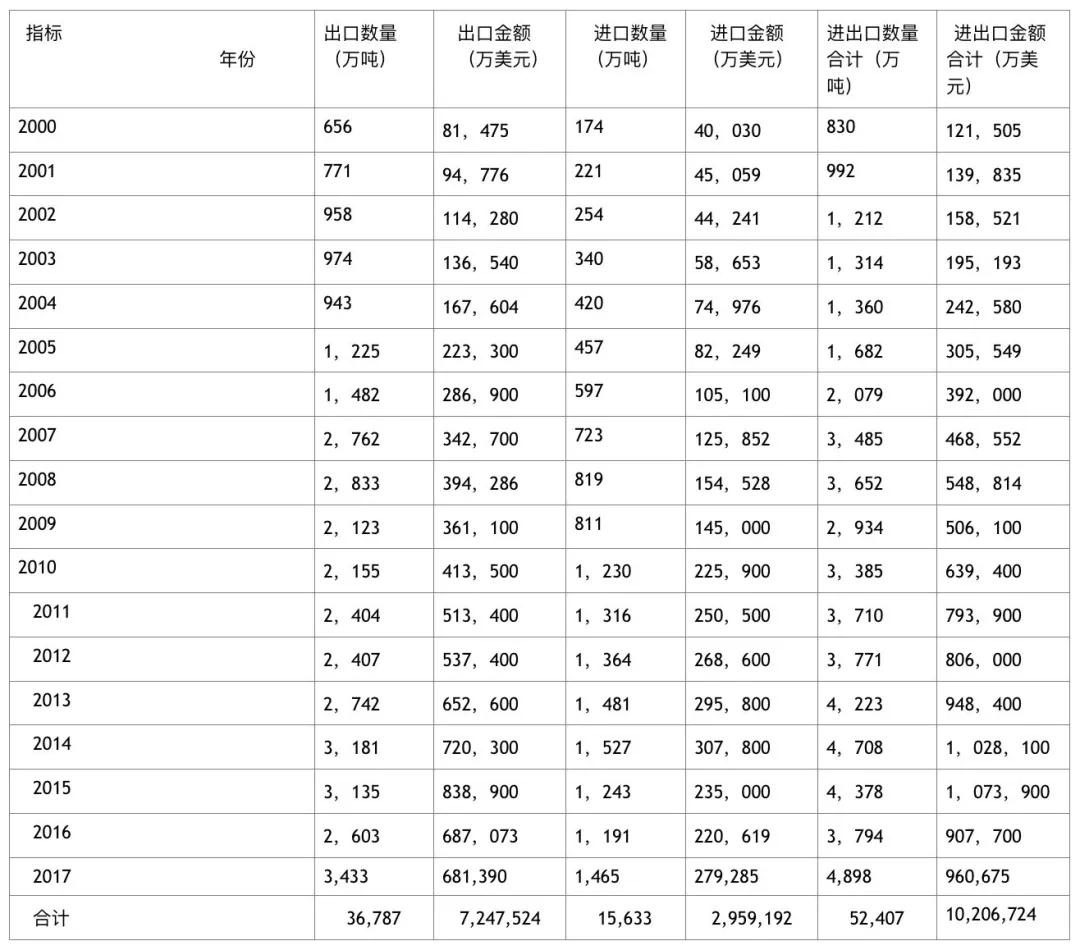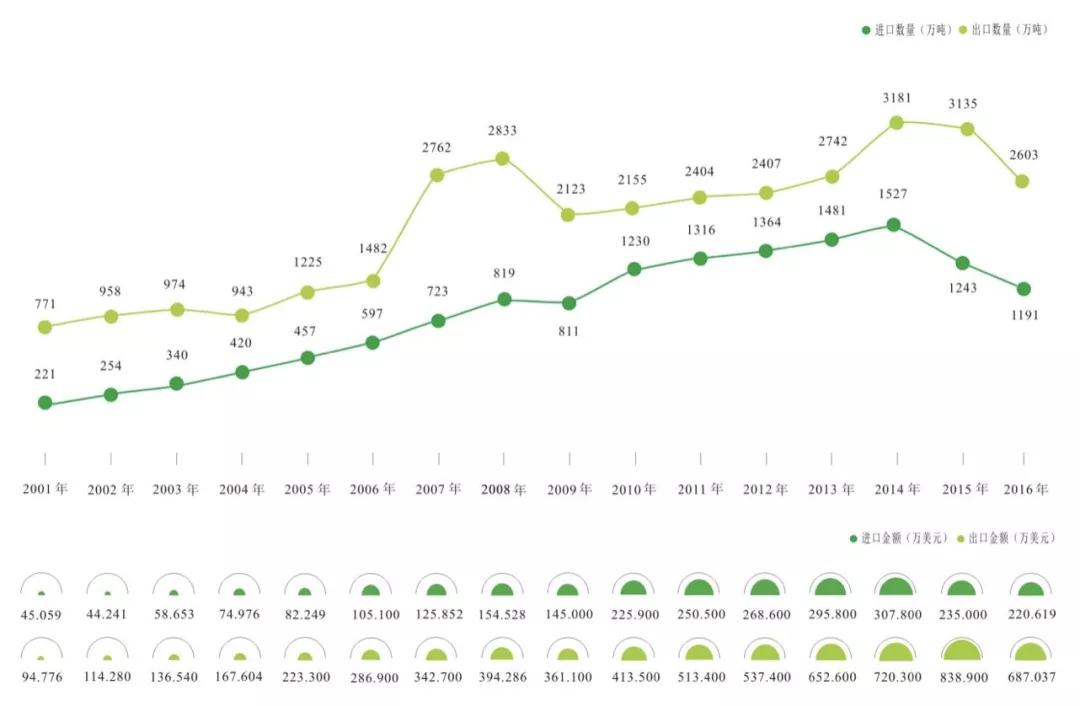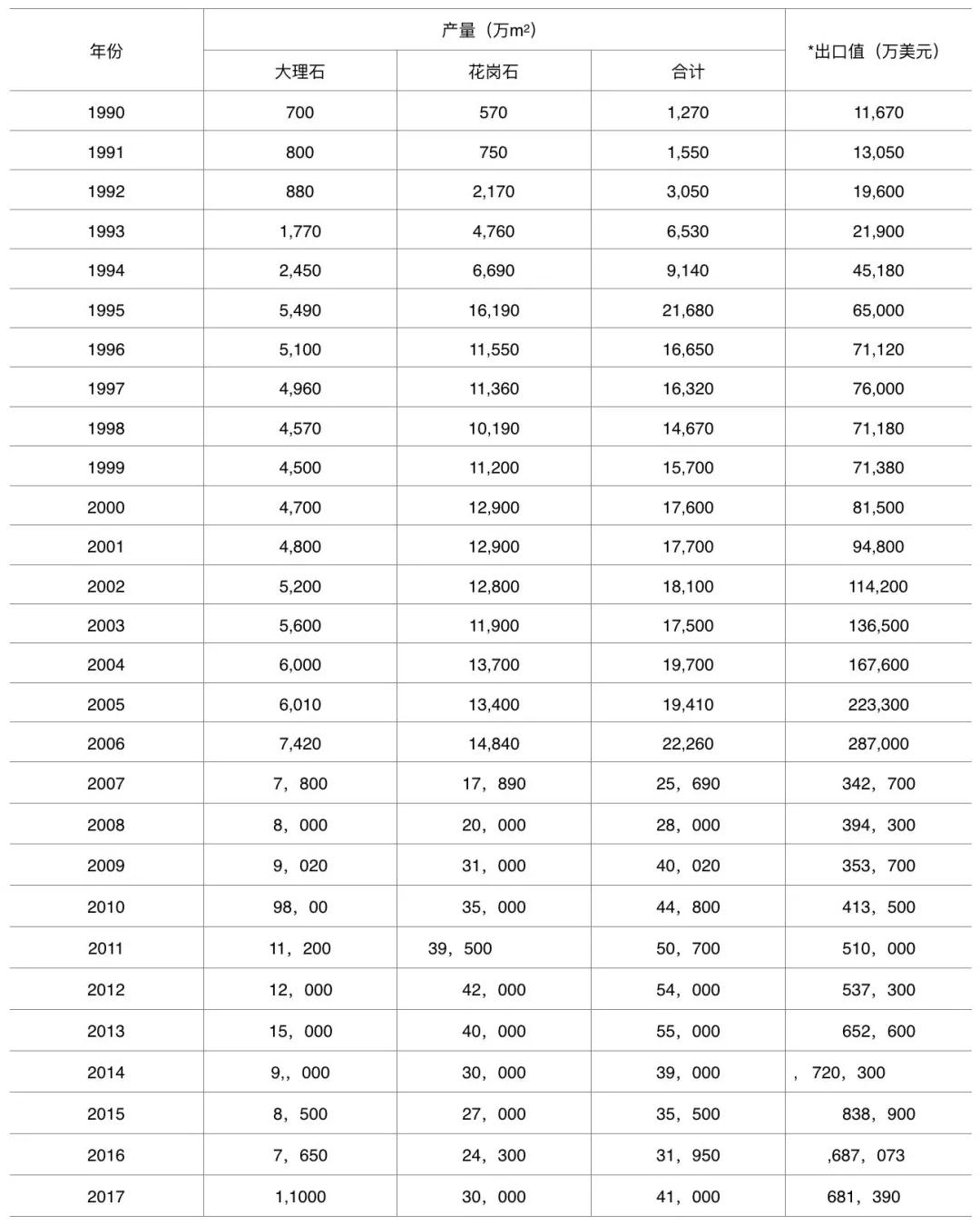Abstract In the past 2017, China's stone trade, as industry experts expected, continued to succumb to exports; imports were very eye-catching and re-emerged at high growth. In 2017, China's stone import and export international trade total, after falling back to 10 billion US dollars in 2016, 201...
In the past 2017, China's stone trade, as industry experts have expected, exports continue to linger; imports are very eye-catching and reproduce high growth. In 2017, China's stone import and export international trade total, after falling back to 10 billion US dollars in 2016, the total import and export in 2017 is still within the billion-dollar mark, reaching only 9.606 billion US dollars, 49.08 million tons. The export was basically the same as that of the previous year; while the import was very outstanding and the growth was obvious. This is closely related to China's current macroeconomic policy and eco-environmental protection policy, and it is evenly imbalanced or lacking with China's huge stone demand and stone resource reserves. - In particular, there is a direct relationship between the shortage of marble resources.
Recently, the China Stone Association has just learned from the General Administration of Customs: In 2017, China's total import and export of stone was only 9.606 billion US dollars, 49.08 million tons, compared with the previous year, an increase of 5.84%, 29.36%. In 2017, exports amounted to 6.814 billion US dollars and 34.43 million tons, an increase of -0.83%% and 31.89% respectively over the previous year. The reason for the significant increase in weight is the increase in the number of stone powder and stone granules. It is necessary to explain this. It is not decorative stone, its growth is too big, which drives the whole number of growth); while the import is 2.793 billion US dollars, 14.65 million tons, which is 26.78% and 23.21% higher than the previous year respectively. It should be said that this is synchronous. . That is to say, in the past 2017, China's stone trade showed a high growth in both imports (including amount and quantity), second only to the best import levels in 2013 and 2014, while exports were once again rampant. After deducting the increase in the amount and quantity of stone powder and stone granules, in fact, China's stone exports in 2017 were negative growth.
(1) 2017 China Stone Export Big Data
According to the 2017 China Stone Trade Summary Table, the varieties exported in the same year were mainly concentrated on several major numbers such as building stone, marble stone, granite stone, marble finished product, granite product, stone composite board and synthetic stone. . Synthetic synthetic stone grew rapidly in 2017, reaching 1.15 billion US dollars and 650,000 tons. This single item has doubled compared with 2016, and the net growth is about 575 million US dollars, about 200,000 tons. Synthetic synthetic stone once again became the "dark horse" that drove China's export growth in 2017. If the growth of China's synthetic synthetic stone in 2017 is deducted, the actual Chinese stone exports in 2017 will be negative. It further shows that the growth of China's stone export growth has further increased. Just as the author has listed the international situation last year, the factors affecting China's stone exports still exist this year, and they are even worse. They are still: the war in the Middle East has been going on for several years and there is a great spread, and the crisis in Eastern Europe is still unresolved. The timetable, the shadow of the EU terrorist attacks are not scattered, the British Brexit is a reality, Japan’s economic growth tends to be negative... and the annual growth indicator of China’s economic GDP is eye-catching, etc., which makes China’s stone trade exports not May be "out of the box". Therefore, the future international situation will prompt China's stone exports will continue to be depressed and uncertain. But we are still seeing a sudden rise in synthetic synthetic stone in the downturn - we have to make a special explanation for the export of synthetic synthetic stone.
(2) 2017 China Stone Import Big Data
In 2017, China's imported stone is still mainly marble blocks and granite blocks, while import growth is mainly reflected in marble blocks (1.7 billion, 8.4 million tons) and granite blocks (9.5 billion, 5.7 million tons). These two of the two most important imports account for 95% of total imports ($2.792 billion). It shows that the domestic imported stock varieties have been released, consumed and digested in different degrees, and the market consumption demand has increased. Experts predict that China's imported stone will return to a high growth period and enter the third highest level in history (referring to the third highest level after the highest level in 2013 and 2014), which is the inevitable result of the Chinese market demand. On the one hand, our country has entered a stage of high-quality growth from high-volume growth, and people's living standards have also entered a stage of high-quality growth. Stone home improvement has gradually been recognized, accepted, and implemented by more home decoration; Second, the state strongly advocates the construction of ecological civilization. The stone industry in many areas of China, especially the development of stone along the coast, along the lake, along the river and along the forest, has been banned. Some provinces and municipalities have issued the “Ecological Red Line”, and a large number of stone mines have been closed; Third, China's most suitable marble for indoor decoration has been in short supply, which has caused the most obvious growth of marble blocks in imported stone in 2017, reaching a net increase of nearly 550 million US dollars, an increase of about 2 million tons, and becoming 2017. The most important part of China's stone import growth in the year. Of course, imported marble does not have the factor of hot money speculation, we will talk about it later. At present, the approximate proportion of marble and granite imported from China is 8:5, that is, 5 tons of granite should be imported for every 8 tons of marble imported. From the current trend, if China continues to maintain the above three basic policies, China's stone imports will continue to rise in 2018. And the price of imported stone will continue to grow (in 2017, the import price increased significantly compared with 2016, the average price increased by 15%, the average import price in 2016 was 193 US dollars, and the average import price in 2017 was 221 US dollars). This is extremely unfavorable for China’s countries that mainly process imported raw materials.
Looking at China's stone trade in 2017, we have reason to believe that China is still the world's most active stone production and consumption market, and the total trade share in the world stone industry will remain at around 25% to 30%.
(3) The basic situation of China's stone import and export data and China's stone trade in 2017 in recent years
If the basic situation of China's stone import and export in 2017, put it on a historical node, what is the situation?
Summary of China's Import and Export Stones from 2000 to 2017

Note: This form was compiled by Hou Jianhua according to the summary table of China's stone import and export trade from 2000 to 2017 by the General Administration of Customs of China.

China's export and import stone trend chart from 2001 to 2017

Production and export value of Chinese stone from 1990 to 2016
Note: The stone export value data in the table is compiled by the China Stone Association Hou Jianhua according to the annual report of the State Administration of Customs of China, the former State Building Materials Bureau and the China Stone Association Annual Report.
Analysis of 2017 China Stone Export Data and Structure
(1) Analysis of China's export data and key countries in 2017
In 2017, China's largest exporter of natural stone (excluding synthetic synthetic stone) was South Korea, 2.41 million tons, 1.038 billion US dollars; the second largest country was the United States, 656,000 tons, 610 million US dollars; the third was Japan, reaching 546,000 Tons, $ 449 million, Vietnam reached fourth, 420,000 tons, $ 265 million; India climbed to 200,000 tons, $ 215 million; Germany was 664,000 tons, $ 168 million, UAE 142,000 tons, $ 96 million The Netherlands, 192,000 tons, $72 million; the United Kingdom, 155,000 tons, $65 million; Belgium, 33,000 tons, $16 million; China Taiwan, 59,000 tons, $27 million.
Such export seats seem to be very good to see, but in recent years, artificial synthetic stones have sprung up, which has greatly changed the momentum of China's export market. Because of the data from the export of synthetic synthetic stones: the United States, 330,000 tons, 709 million US dollars; Canada 27,000 tons, $ 81 million; the United Kingdom, 21,000 tons, $ 52 million; South Korea is less, only 29,000 tons, US$22 million, which is a far cry from its natural stone imports; Brazil, 26,000 tons, $43 million; Australia, 29,000 tons, $47 million.
US market: When we look at the export of natural stone, South Korea is the largest market, but the United States, together with synthetic synthetic stone, has become the first, with a total value of 1.3 billion US dollars, far exceeding South Korea's 10.6 (1.038 billion natural +0.22 artificial stone) billion dollars. The United States is still firmly in the first place. The US's 1.3 billion import value is equivalent to one-fifth (20%) of China's exported stone.
The rise of synthetic synthetic stone is directly related to the technological innovation, product innovation, high self-sufficiency of equipment, abundant self-sufficiency of raw materials, variety diversity, substantial improvement of quality, improvement of brand value and strong service orientation. . It must be the fastest growing part of the stone trade in the future.
Korean market: still the first market of natural stone, with granite stone, decorative stone, garden stone and stone;
Japan: mainly stone, tombstones, decorative stone; while the tombstones of the past have decreased;
Vietnam market: mainly stone and decorative stone;
European market: the countries of Europe are basically decorative stone for construction, with a small amount of tombstone;
Here we will talk about the Indian market: in 2017, China imported 200,000 tons and 215 million US dollars of marble and granite products, totaling more than 200 million US dollars, which is a milestone in India. It can be seen that India's economic growth momentum is also reflected in the stone industry.
(2) Forecasting future trends of export data (variety, country)
Based on years of data, we have reason to believe that China's stone export varieties, countries, seats, and quantity will not change much in the near future. The “Belt and Road” stone that everyone is paying attention to has not grown much. But the only synthetic synthetic stone exports may speed up – because this “black horse” is mature in China.
For other countries with small import and export data, we will check the data for you after the meeting.
Analysis of 2017 China Stone Import Data and Structure
(1) Analysis of 2017 China import data and key countries
Marble blocks: Obviously the winner of 2017 is Turkey, which exports to China (marble): 4.31 million tons, 955 million US dollars; ah! The second race is Italy, which has been sleeping for many years: 649,000 tons, 185 million US dollars; the third is Iran, 843,000 tons, 144 million US dollars; the fourth is Egypt, 910,000 tons, 114 million US dollars; the fifth is Spain, 315,000 tons, 0.6 billion US dollars; sixth is Greece, 245,000 tons, $49 million; seventh Portugal, 210,000 tons, $31 million; eighth is Palestine, 180,000 tons, $23 million. These marbles total approximately $1.7 billion and 8.48 million tons.
Granite blocks: The first place is still India (has been in the position for many years, has never been shaken), 4.38 million tons, 677 million US dollars, has been firmly holding the position of China's largest granite importing country for many years; The second is Brazil, with 710,000 tons and 141 million US dollars; the third is Norway, 100,000 tons, and $27 million; the fourth Saudi Arabia, 32,000 tons, and $15 million; the fifth Finland, 100,000 tons, and $14 million. Sixth South Africa, 75,000 tons, $ 0.13 billion. In 2017, China's granite blocks imported a total of about 900 million US dollars, 5.52 million tons.
Other countries that have little import data will be available to you after the event.
(2) forecasting the future trends of the data (variety, country);
China mainly imports stone blocks because China's processing capacity is too strong. The marble and granite blocks in the imported stone are the most important varieties. The ratio of marble to granite is 8:5, which means that about 5 pieces of granite blocks are imported per 8 pieces of marble blocks. .
In 2017, only Xiamen Port imported 1.3 billion US dollars, about 8 million tons of marble blocks, granite blocks.
A. Imported marble blocks from Turkey still occupy the first place in China's imports
In 2017, China imported 4.31 million tons of marble from Turkey, 955 million US dollars. In 2016, China imported a total of 671 million US dollars of Turkish marble, 3.3 million tons, compared with 640 million US dollars in 2015, 3.2 million tons; and only 243 million US dollars in 2009, In the past eight years, the net increase was nearly 700 million US dollars; from the Turkish country to China's stone, it accounted for 30% of the total import of 14.65 million tons of stone in China.
The main reason Hou Jianhua believes: Turkey is located on the Mediterranean coast, and the formation of marble deposits in Greece, Italy and Spain belongs to a geological tectonic age, which is different from the Egyptian sedimentary rock marble. The marble along the coast is the middle and upper grade in marble. The material is the material that designers and architects love for ten minutes. In recent years, Turkey has vigorously developed the stone industry and introduced a number of policies to support the development of the industry, such as small and medium-sized enterprise rescue funds and equipment import tax reduction and exemption policies. In recent years, China’s investment in mines and processing plants in the country has gradually been put into place, which has contributed to the rapid growth of Turkish marble production to a certain extent.
Turkey's export of marble to China can grow rapidly. It has several conditions: First, for China's huge imports, it is closer to the traditional European countries; second, it belongs to the same sedimentary rocks, metamorphic rocks, and the quality of Italy and other countries. The big difference is that the cost is much lower. Third, the production cost and labor cost of Turkey are much lower than those of southern European countries such as Spain and Italy. Fourth, compared with other countries, Turkey’s investment and entry threshold for small and medium-sized enterprises is also To be much lower, the driving force for attracting foreign investment is greater; the fifth is China's huge domestic demand and the demand for the external processing market. Such as China Light Stone, the annual operation of Turkish marble, the annual import volume reached 1.5 million tons and so on.
B. China imports granite, India is still firmly in the first place
In 2017, China imported 4.38 million tons of Indian granite blocks, which was 6.7 million US dollars, which was still higher than 2016. It still ranked first. Although India’s exports to China declined in 2016, it still 553 million US dollars, 3.5 million tons ranked first in China's imports of granite. And in 2015 it was $ 630 million, 3.88 million tons, down from 2016; Quantitative terms, a single India alone accounts for 70% of the year China imported granite; granite and 2017 than in 2016 in India Increase (6.77-5.53) $124 million, +22.4%.
There are three main reasons here: First: the variety is suitable for the Chinese market - like black gold sand, Indian red, British brown, etc.; second: the price can be received in China, and is suitable for sand saw reprocessing; third: the product has high physical and chemical properties - - Cost-effective. The author analyzes that China will continue to rely on imports for a long time in terms of gorgeous color granite. This is closely related to the lack of such resources in China. We know that China is a big country of granite, but mostly gray, yellow, pink, green - and mostly light tones. There are few gorgeous and exotic varieties, which leads to only imports.
In addition, Brazil's 141 million, 720,000 tons, compared with the previous year, but not much; in addition, South Africa, Finland, Norway, the United States, Namibia have decreased compared to the previous year.
C. The growth of imported marble plates from Egypt is impressive.
Egyptian marble, which is mainly composed of sedimentary rocks, first exported more than US$100 million to China in 2010, reaching US$1.00247 billion, and in 2015 it reached US$120 million. (2016 remains at $110 million). In 2017, it was 9.1 million tons and $114 million. The number did not change much. This figure is not a big figure in itself. However, for a Middle Eastern country with a national export of only over 4 billion US dollars, it is a big increase. It is reported that in 2007, the annual export of Egyptian stone was only 400 million US dollars, and most of them were blocks, which accounted for 1/10 of the country's total export value. By 2010, stone exports had reached about 600 million US dollars, accounting for 15% of Egypt's national exports, about 1/6. And the $120 million marble sheet is obviously very important. Egypt thanks to a strong proponent of the past few years to increase tariffs, the adjustment of export product variety, structure-oriented trade policy - in a word, the Egyptian foreign trade products but also by the increase in value.